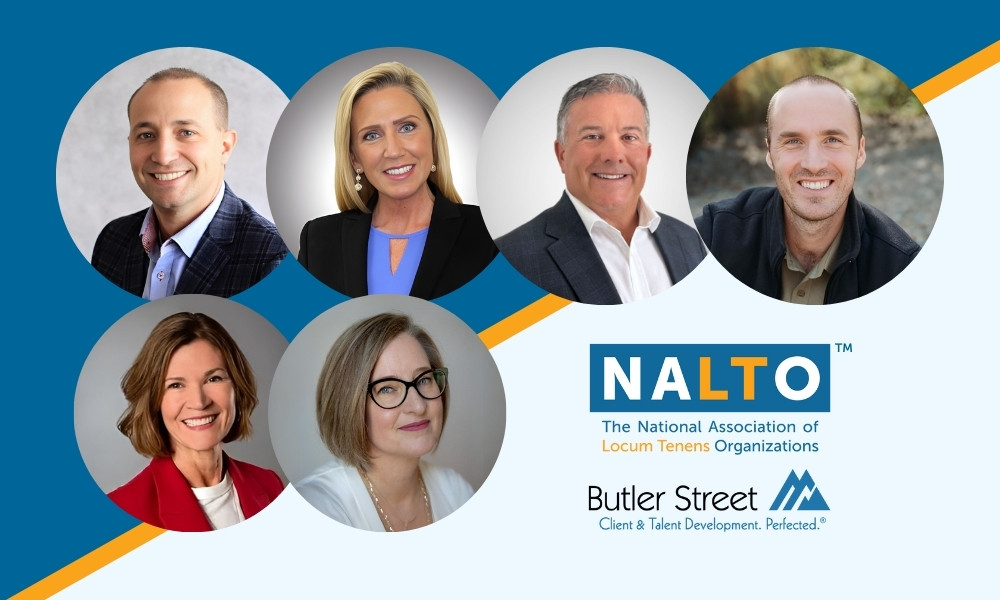Locums Digest is Locumpedia’s roundup of hot topics, top stories, and social media posts of interest to the locum tenens and medical communities. Subscribe to our newsletter to receive Locums Digest before it’s published here.
Locumpedia Recognizes Healthcare Recruiters
(Edited from a Nursing.com article by by Eileen Williamson, MSN, RN, and from “Recognizing National Healthcare Recruiter Recognition Day,” by TeamHealth’s Lisa Barto and Alison Cooper)
Healthcare recruiters, you are amazing! And the month of June is the perfect time to tell you.
It turns out that way back in 1991 — 30 years ago this year, Congress declared “National Healthcare Recruiter Recognition Day” should be celebrated each year on the first Tuesday of June to recognize healthcare recruiters’ work with clinicians, healthcare facilities and patients.
The designation marks an opportunity for the healthcare industry to focus on how healthcare recruiters contribute to patient care by identifying the best applicants and selecting the best candidates to fill the many positions and roles needed in healthcare.
Many clinicians who’ve benefited from your services realize there’s no vacation from recruitment: You work full-time, part-time and often overtime in different settings from small hospitals to large healthcare systems, nursing homes, rehab centers, ambulatory care facilities, healthcare staffing agencies and more.
Juggling Act
You do more than ‘smiling and dialing.’ Your responsibilities range from establishing yearly recruitment plans/budgets, to traveling to represent your employer at career fairs, to working with your leadership teams at the decision-making table.
You screen resumes, arrange interviews and follow candidates (and their managers) through early stages of the employment process. You need many skills and wear many hats: You’re a collaborator, liaison and colleague — a marketing and sales representative of a different sort.
“Your role is one in which time is of the essence and the mandate is filling each vacancy with the best candidate in the least amount of time,” Nurse.com author Williamson notes. According to TeamHealth blog authors, “Recruiters source and hire the most talented clinicians whose core values align to [the employer’s] dedication to clinical quality and patient safety.”
Further, TeamHealth authors noted recruiters strive to ensure they not only identify the best clinicians, but also secure the best position available for the clinician. “Skilled recruiters…get to know [each] clinician to understand how best to serve [him/her]. They also recognize clinicians are busy, so they prioritize clear and timely communication.”
On National Healthcare Recruiter Recognition Day 2020 (June 3), TeamHealth recognized its recruiters for their “vital work and selfless dedication…“Thank you for the passion you exhibit every day, and thank you for positively impacting the lives of each patient seen by the clinicians whom you have recruited.”
All News Is Locums
Consilium Postcard Drive Supports Veterans with Cancer
(Edited from PRNewswire release, May 25, 2021)
Consilium Staffing employees sent 108 handwritten postcards to Fayetteville Veterans Affairs Medical Center (VAMC) to honor patients during Military Appreciation Month (May). Each postcard contained an uplifting message to encourage and support veterans undergoing cancer treatment. The postcard drive was led by Consilium Cares, the dedicated philanthropic initiative of Consilium Staffing.
How to Get Your CME Credits as a Locum Tenens Physician
(Edited from 5/28/2021 blog post by Allison Riley for locumstory.com)
For physicians who work as independent contractors (“locum tenens physicians”), getting CME credits can present challenges of affordability and access. However, during the pandemic, many medical and professional associations moved their meetings and offerings online.
As in-person medical conferences resume, many associations continue to offer online courses and classes, making it easier than ever for clinicians to earn CMEs. Consider these resources if you’re looking for ways to earn continuing medical education (CME) credits without ‘attending class’ in-person.
American College of Physicians (ACP)
ACP offers hundreds of curated CME activities organized by topic, product and format to match physicians’ interests and needs, many of which are free or discounted for ACP members. In addition to live meetings, physicians can earn CME credits by working online or watching course recordings on their own schedules.
CME List, Inc.
CMEList, Inc., maintains a comprehensive list of CME activities including board reviews, conferences, journal summaries, lectures, and other activities that can be completed for CME credits. CMEList sorts CME credits by specialty, topic or profession, making it easy to find courses and credits, including hundreds of free continuing medical education courses.
Contemporary Forums
Contemporary Forums Online offers accredited, on-demand continuing education for healthcare professionals. Contemporary Forums’ online courses are ANCC/ACCME accredited, continuously updated and easy to access, so providers can earn CME credits at their desired pace.
HMP Global
HMP Global is a multi-channel producer of healthcare content, meetings and education. In partnership with the North American Center for Continuing Medical Education (NACCME) and Imedex, HMP Global offers educational programming across a range of therapeutic areas and in a variety of formats, including live webinars and on-demand webcasts.
Medscape Education
Medscape Education is a leading destination for continuous professional development, comprising 30+ specialty-focused websites offering thousands of free CME/CE courses. Medscape Education is available through a variety of formats, including clinical news briefs, patient simulations, clinical cases, expert commentary videos, conference coverage and more. The Medscape Help Center is a great place to get started and review FAQs.
myCME
myCME is a provider of continuing medical education developed in collaboration with prominent academic institutions, medical societies/associations, Haymarket Medical Education, and other quality accredited providers. MyCME offers hundreds of complimentary online CME/CE programs certified by ACCME-accredited providers for clinicians across the full spectrum of medical specialties. Courses and content are organized by specialty and disease topic, for ease of review and use.
Other Ways to Earn CMEs
The American Medical Association (owner of the AMA PRA credit system) offers ideas for unconventional ways to earn CME credit, many of which physicians might have earned without realizing they qualified as ‘continuing education.’
Activities that may be eligible for credit include publishing articles, authoring poster presentations, teaching at live activities, or pursuing a medically-related advanced degree. While not overseen by an accredited CME provider, these activities — and others — are recognized as valuable learning experiences by the AMA and may qualify for CME credit.
If you’re a locum tenens provider in need of CME credit, there are myriad options, many accessible online. You don’t have to have a corporate sponsor to continue developing in your practice and career.
The Healthcare Staffing Story
Aya Healthcare to Acquire Temp-Staffing Div. of NM Hospital Association’s Hospital Services Corp.
(Edited from Aya Healthcare release om PRNewswire, 5/26/2021)
Healthcare staffing provider Aya Healthcare’s Qualivis subsidiary is acquiring the temporary staffing division of the New Mexico Hospital Association’s (NMHA) Hospital Services Corp. The deal was expected to close June 1.
“As hospitals faced workforce challenges due to the COVID-19 pandemic, we’re thrilled to join Qualivis to provide our members with robust software and services to increase healthcare system access to temporary staffing any time they need it,” NMHA Services Corp. President Erika Campos said.
Hospital Services Corp. began operating to offer services to NMHA-member hospitals. It has since begun serving a broader range of healthcare customers including health plans, physician offices, medical clinics and businesses outside the healthcare industry.
“Our focus is to fill critical gaps to deliver high-quality healthcare to communities in need,” Qualivis President Sherry Kolb said. “We’re excited to welcome NMHA and provide its members with a suite of workforce solutions to drive staffing efficiencies, provide quality candidates and increase savings.”
With the addition of NMHA, Qualivis has relationships with 26 state hospital and healthcare associations.
The Conference Board: Labor Shortages Return
(Edited from SIA Daily News, 5/28/2021, and “Labor Shortages Are Making a Comeback,” by Gad Levanon, PhD, for The Conference Board)
Introduction to Full Report:
“Before the pandemic hit in early 2020, the US was experiencing a labor shortage, especially in blue-collar and manual-services jobs. But when the unemployment rate reached 15% in April 2020, such scarcity seemed unlikely to return in the foreseeable future. One year later, however, unemployment rates remain elevated, but qualified workers are hard to find.
“According to an April survey by the National Federation of Independent Businesses, 44% of firms say they have job openings they are unable to fill right now, the highest rate in the history of the survey.”
Labor shortages return as the COVID-19 pandemic wanes, according to a new report from The Conference Board (TCB). “Labor Shortages Are Making a Comeback” examines the factors and forces driving this return to tight labor markets.
The report indicates large segments of the economy are opening simultaneously and labor supply is constrained, resulting in shortages that are likely to remain for most of 2021. Already employers have been deeply affected, qualified workers are hard to find, and retention rates are low.
“Just as job losses in the COVID-19 recession were unprecedented in speed and severity, the post-pandemic recovery has set off a historic set of recruiting difficulties,” TCB VP, Labor Markets, Gad Levanon said. “Some of these reflect unique factors likely to fade by the end of 2021, easing acute hiring troubles. But they are accompanied by a return — or even an acceleration — of the same drivers behind extremely low unemployment before the pandemic.”
Together, these short-run and structural causes will keep labor markets tight until the next recession, Levanon said.
Additional Report Findings:
- Recruiting/retention difficulties are more pronounced in blue-collar and manual services jobs. [Many of] These workers face high infection risk; elevated unemployment benefits are an attractive option for workers with relatively low wages. Tech occupations also are experiencing a tight labor market as the US economy shifts to more online activity and digital transformation grows.
- Wages are accelerating. Companies are reacting to the labor shortages by raising wages, especially in the leisure and hospitality sectors, and in blue-collar and manual-services occupations.
- After a pause in 2022, tight labor markets will remain until the next recession. Labor shortages may ease by the end of 2021, but they may reappear as soon as late 2022. Also, for the first time in US history, the working-age population is shrinking as many baby boomers retire. Though this demographic shift will create increased demand and job opportunities as younger unemployed job seekers take up these positions, the unemployment rate will lower.
- For the first time in US history, the working-age population is shrinking.
- A mix of recruitment strategies can help alleviate labor shortages. Some of the quickest and most impactful solutions involve changing the recruitment process, implementing tactics like adding or modifying employee referral programs, contracting with staffing firms, or implementing technologies to streamline recruitment. Another strategy is expanding recruitment into new demographics, populations and geographies.
- Companies should reevaluate, and possibly lower, credential requirements [not so easy in healthcare staffing]. To increase the available candidate pool, organizations could lower requirements for prior experience and for skills/competencies. However, lowering hiring requirements often creates a need for increased investing in improving new recruits’ skills and development.
- Remote hiring offers an opportunity to recruit candidates previously out of reach. Inclusion of candidates who can work remotely means employers can cast a wider net.
Tools to Try/News to Use
Upcoming NALTO Webinar: Be Successful Selling Virtually
(Edited from LinkedIn Post by NALTO)








